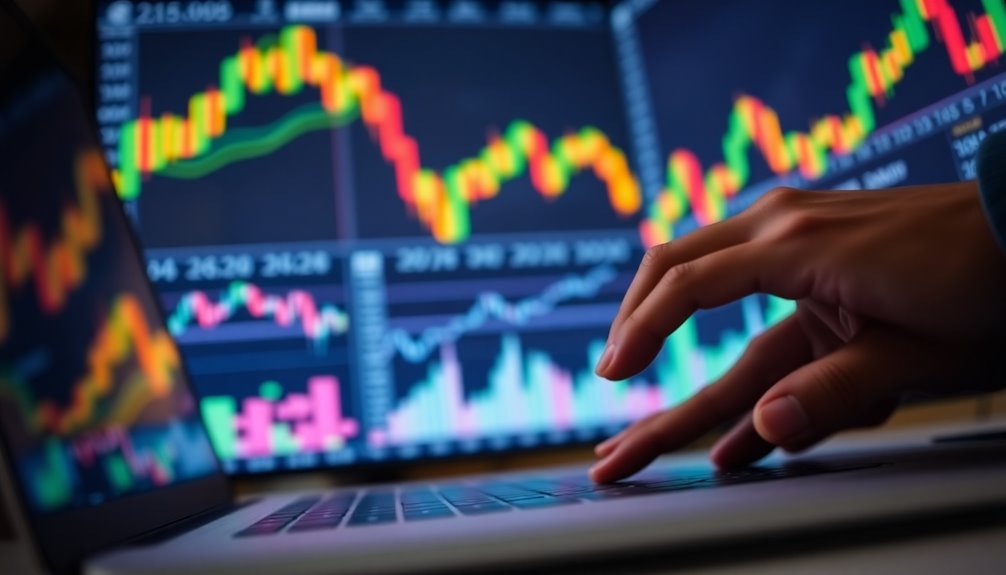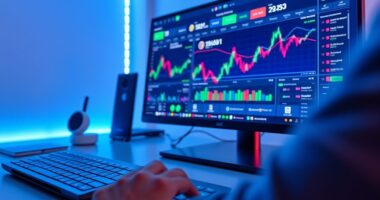Understanding cryptocurrency trading volume is crucial for your trading success. It measures the total amount of an asset traded in a given time, usually 24 hours. High trading volume indicates a liquid market, allowing you to make large trades without significantly impacting prices. By observing volume changes, you can spot potential price movements and trends. Spikes in volume often correlate with market sentiment and can signal upcoming price changes. To navigate this dynamic market effectively, grasping the patterns and indicators tied to trading volume will enhance your strategies. There's so much more to explore about trading volume and its implications.
Key Takeaways
- Trading volume indicates market liquidity; higher volumes allow for larger trades with minimal price impact and reflect active buying or selling interest.
- Volume changes can signal potential price surges or reversals, acting as a leading indicator in confirming price trends.
- Different time frames, such as daily or weekly volumes, provide insights into short-term activity and long-term market stability.
- Volume-based indicators, like On-Balance Volume and Money Flow Index, help traders make informed decisions about entry and exit points.
- Be cautious of wash trading, as it can distort volume readings and create misleading market perceptions; combine volume analysis with other indicators for accuracy.
Trading Volume Explained

Trading volume is a key metric in cryptocurrency markets, representing the total amount of a digital asset traded over a specific timeframe, usually 24 hours. It quantifies how many coins are exchanged, either bought or sold, during that period. This metric helps you gauge the activity level for a particular cryptocurrency.
You can measure trading volume across various time frames—daily, weekly, or monthly—each providing unique insights into market trends. High trading volume typically indicates a liquid market, making it easier to execute large trades without affecting prices significantly. High trading volume(indicates a liquid market) also leads to smaller price spreads, reducing costs for traders. Additionally, observing changes in trading volume can be essential for identifying potential upcoming crypto surges, as it often reflects increasing interest among investors.
A surge in volume can signal strong market sentiment, reinforcing the likelihood of ongoing price movements. Always consider different exchanges, as they may report varying trading volumes for the same asset.
Market Activity Overview

Understanding market activity is crucial for navigating cryptocurrency trading effectively.
You'll notice that trading volume tends to spike during both bull and bear markets, as investors actively buy and sell. When prices fluctuate, volatility often drives higher trading volumes, reflecting immediate market reactions. In 2018, Bitcoin led with $1.3 trillion in annual transaction volume, highlighting its significant role in market activity.
Keep an eye on market sentiment, as news and events can significantly influence trading activity. Daily volumes show short-term trends, while weekly and monthly patterns indicate longer-term stability.
Major cryptocurrencies like Bitcoin and Ethereum set the tone for the market due to their dominance, impacting overall liquidity.
Lastly, trading volumes across various exchanges also enhance market liquidity, making it easier for you to execute trades efficiently.
Transaction Frequency Analysis
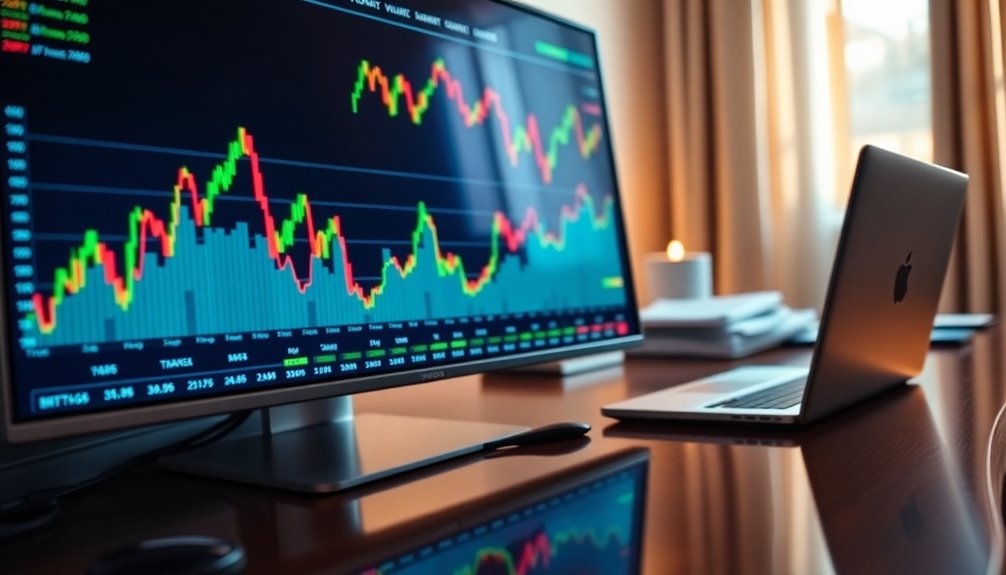
Market activity not only reflects overall trading volume but also reveals insights into transaction frequency, which plays a significant role in shaping price movements.
You'll notice that high-frequency trading aligns with Asian, European, and U.S. trading sessions, creating distinct activity phases. For instance, bursts of trading in Bitcoin and Ethereum often coincide with the release of crucial U.S. macroeconomic reports. This correlation indicates that external factors significantly influence repeatable market dynamics.
Intraday activity tends to spike in 15-minute intervals, especially at the start of each hour, suggesting algorithmic trading's influence. High transaction frequencies contribute to trading volumes, impacting market efficiency and volatility.
Essentially, as you track these frequencies, you'll see how investor sentiment and market dynamics interact, affecting price momentum and overall market behavior.
Pros and Cons
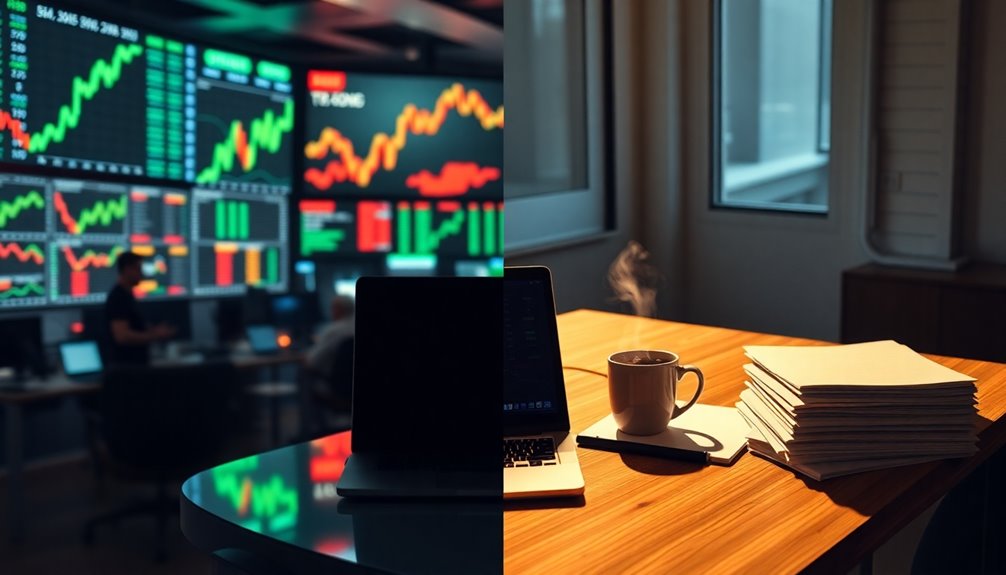
When evaluating cryptocurrency trading volume, it's essential to recognize both its advantages and drawbacks.
On the positive side, high trading volume indicates increased liquidity, allowing you to enter and exit trades more easily while minimizing price slippage. It also helps in identifying market trends and offers insights into potential price movements. Additionally, trading volume can serve as a valuable metric for assessing the strength of a cryptocurrency.
However, there are downsides to consider. Wash trading can distort volume readings, creating false signals and misleading perceptions of market strength. Additionally, high volume doesn't always guarantee stability; it could indicate panic selling or a bear market.
Relying solely on volume can also mislead novice investors, as it should be analyzed alongside other market indicators for a comprehensive view.
Volume vs. Price Correlation
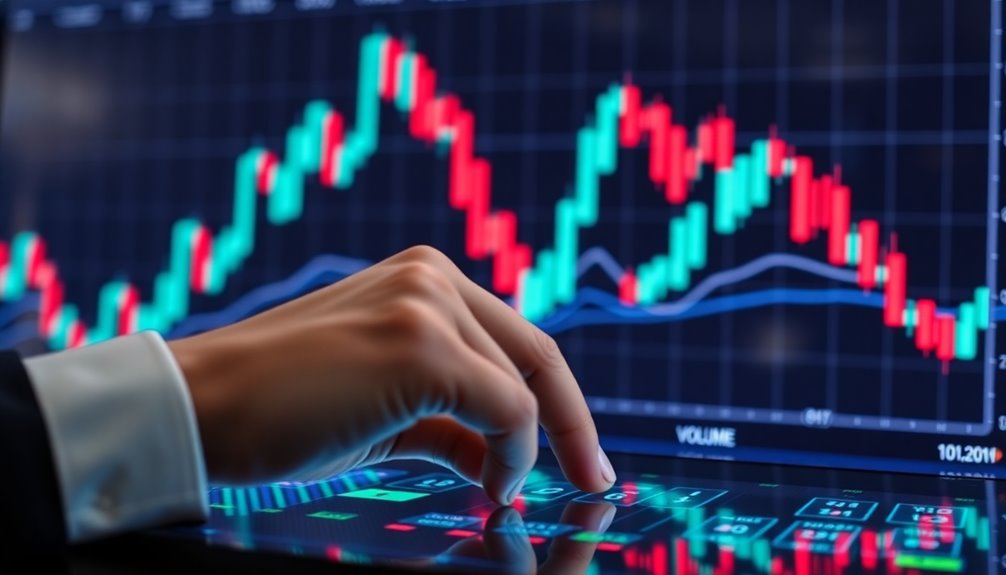
Although many traders focus primarily on price movements, the correlation between volume and price plays a crucial role in market dynamics. Price changes often lead to shifts in trading volume, indicating that price can act as a leading indicator.
For instance, when Bitcoin experiences a positive price shock, it typically results in increased trading volume, reinforcing the upward price trend. Conversely, negative price shocks can dampen trading volume, highlighting the interdependence of these variables.
Additionally, high trading volumes enhance market liquidity, leading to more stable prices. Understanding this correlation can help you anticipate market movements and make informed trading decisions, as significant volume fluctuations often signal upcoming price changes or reversals. In fact, total volume traded correlates directly with volatility levels in cryptocurrency markets, further emphasizing the importance of volume in trading strategies.
Market Volatility Concerns
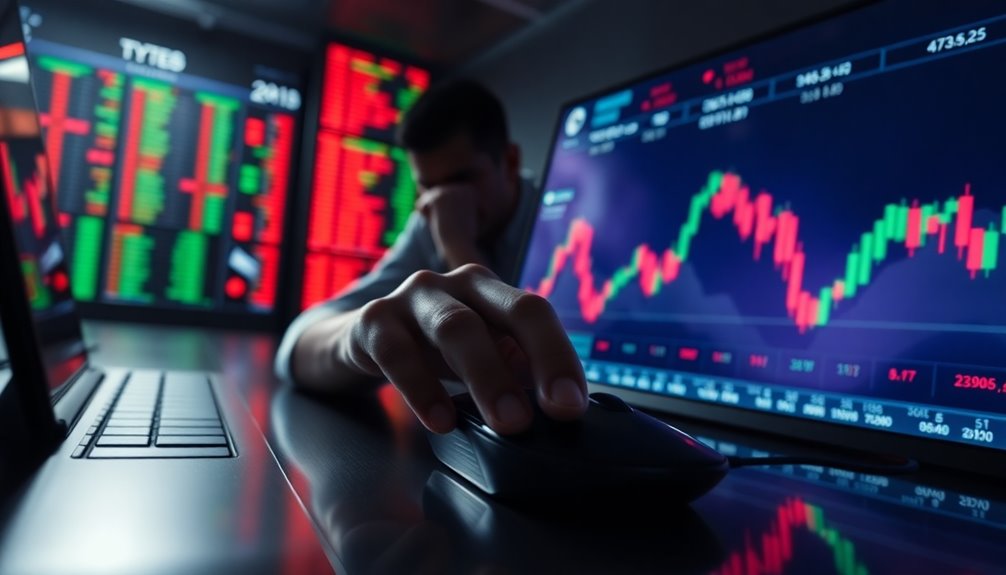
As you navigate the world of cryptocurrency, concerns about market volatility can loom large, affecting your trading strategies.
Regulatory changes play a crucial role; positive news, like spot Bitcoin ETF approvals, can spark rallies, while negative actions, such as bans from major players, might trigger sharp declines. The anticipation of regulatory oversight can foster investor confidence, leading to increased market participation.
The limited supply of cryptocurrencies, particularly Bitcoin's 21 million cap, means sudden demand shifts can lead to wild price swings.
Moreover, low liquidity and trading volume often amplify volatility, as individual trades can drastically impact prices.
Lastly, investor sentiment, fueled by emotions like fear or greed, can provoke erratic market behavior.
Staying informed about these factors can help you make more strategic trading decisions in this unpredictable landscape.
Emerging Defi Trading Patterns
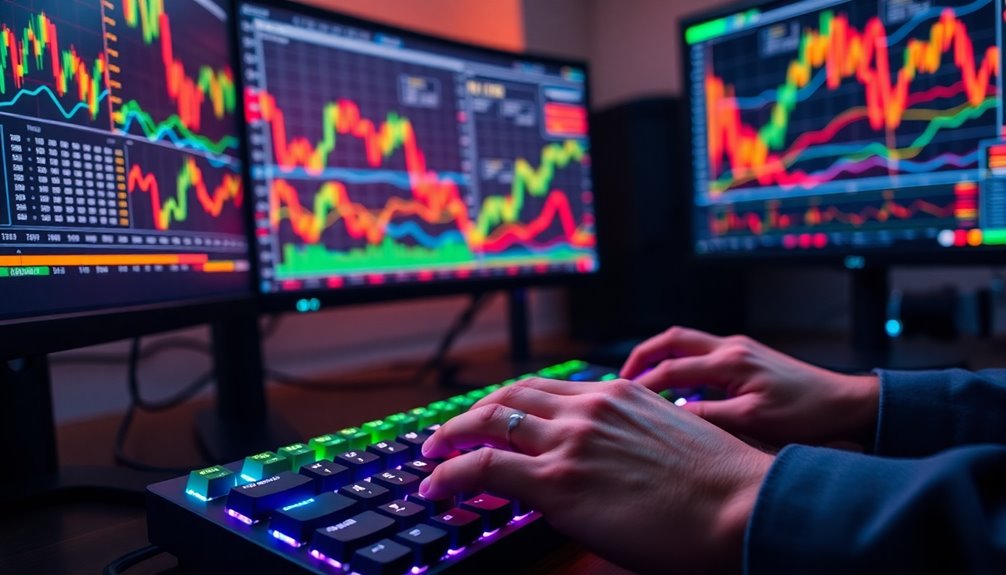
Market volatility often drives traders to explore new avenues, and decentralized finance (DeFi) is rapidly emerging as a popular choice.
With decentralized exchanges (DEXs) like Uniswap, you can trade directly with others without intermediaries, thanks to automated market makers and liquidity pools. Smart contracts handle transactions automatically, allowing for seamless peer-to-peer interactions. Additionally, DeFi utilizes blockchain technology to bypass traditional financial systems, enhancing the overall trading experience.
As a liquidity provider, you can earn transaction fees and governance tokens by supplying assets to these pools. You also have access to various trading options, including spot and margin trading.
Additionally, DeFi lending protocols enable you to lend or borrow crypto, generating interest while maintaining flexibility. These features illustrate how DeFi is reshaping trading patterns in today's market landscape.
Volume-Based Trading Indicators

When you're navigating the complexities of cryptocurrency trading, understanding volume-based indicators can give you a significant edge. Indicators like On-Balance Volume (OBV) help you assess buying and selling pressure by combining volume with price movements. The trading volume reflects market activity levels, which can significantly impact price fluctuations. The Money Flow Index (MFI) reveals overbought or oversold conditions, while Volume Weighted Average Price (VWAP) identifies key support and resistance levels. The Accumulation/Distribution Line tracks price and volume relationships, and Chaikin Money Flow gauges overall money flow into or out of a coin. High volume with price increases signals strong buying interest, while low volume may indicate a lack of conviction.
Frequently Asked Questions
How Can I Track Cryptocurrency Trading Volume in Real-Time?
To track cryptocurrency trading volume in real-time, you can use APIs and websockets from major exchanges like Binance or Coinbase.
Set up alerts through platforms like Telegram or Discord to notify you of significant volume changes. Customize your thresholds based on your trading strategy and utilize volume indicators for better analysis.
Integrating these tools with trading platforms will help you visualize and interpret the data effectively, ensuring you stay informed.
What Tools Are Best for Analyzing Trading Volume Trends?
To analyze trading volume trends effectively, you've got several great tools at your disposal.
Crypto volume trackers provide real-time alerts for significant volume spikes, helping you catch trend shifts.
Platforms like ATAS offer extensive volume analysis tools and educational resources for deeper insights.
Additionally, indicators like On-Balance Volume and Money Flow Index can reveal buying and selling pressure.
Integrating these tools will enhance your ability to make informed trading decisions.
How Does Trading Volume Affect Liquidity in the Market?
Trading volume directly impacts liquidity in the market. When volume's high, you'll find more buyers and sellers, making it easier to enter or exit positions without affecting prices much.
This increased activity tightens bid-ask spreads, reducing transaction costs and attracting even more traders. As liquidity improves, you gain better access to competitive prices, allowing you to trade efficiently.
Are There Specific Times When Trading Volume Peaks?
When the clock strikes overlap, trading volume often peaks.
You'll find that trading activity surges during the simultaneous opening hours of major markets, especially when the U.S. and European markets align. Typically, this occurs late morning to early afternoon in the U.S., drawing in more active traders.
Weekdays generally see higher volume compared to weekends, making it crucial for you to time your trades wisely to maximize liquidity and stability.
How Can Trading Volume Inform My Investment Strategy?
Trading volume can significantly inform your investment strategy.
By analyzing volume trends, you can gauge market interest and liquidity, helping you decide when to enter or exit trades. High volume often confirms price movements, indicating strong buying or selling pressure.
You'll want to monitor volume spikes as they can signal new trends or reversals.
Integrating volume analysis with other indicators can enhance your strategy and lead to more informed decisions.
Conclusion
In understanding cryptocurrency trading volume, you've uncovered essential insights that can shape your trading strategies. By analyzing market activity, transaction frequency, and volume correlations, you're better equipped to navigate the volatile landscape of digital assets. So, as you dive deeper into trading, aren't you curious how these patterns can boost your investment success? Embrace the data, leverage volume-based indicators, and stay ahead of emerging trends to maximize your trading potential in this dynamic market.
